
A rather profane remark first: the Reggia of Caserta has a large underground parking, from where a footpath leads you exactly to the front of the building. Great service in this often so difficult country for an average car driver. Caserta lies just north of Naples, on the way to Rome.
Because of the sunny (though also stormy) weather, I decided to start my visit with the gardens. Water is the central theme here. There's a large "canal" in the center, and innumerable waterfalls and fountains.
Another thing absolutely not to be missed here is the giant staircase that leads up to the apartments. It's all marble where you look, with imposing statues looking down at you. Don't forget to look upwards, where colourful paintings decorate the ceiling.
Keep reading 0 comments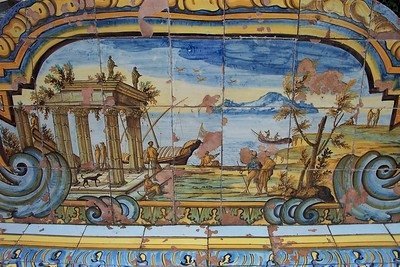
The night before my trip to Naples I read the ICOMOS evaluation of this WHS, which states "It is difficult to identify a city or cities with which Naples might be compared. Its cultural roots are so completely different from those of any other Italian city that comparison would be worthless. It is equally difficult to equate Naples with other major Mediterranean cities such as Barcelona or Marseilles."
There are so many historical city centers on the World Heritage List that this came across as an exaggeration. Walking around Naples by myself proved me wrong, however. Naples is a unique European city, which in my opinion can only be compared to places like Jerusalem and Kathmandu because of the narrow dark streets and the overall highly religious atmosphere.
Probably the artistic highlight of Naples is the inner courtyard of the Santa Chiara monastery complex. Between 1739 and 1742, Domenico Antonio Vaccaro here created a garden with blue, yellow, and green majolica benches and pillars. The surrounding walls are totally covered with frescoes.
In one day you can only get a glimpse of this fascinating city. Another part that I loved is the area around Via San Gregorio Armeno. This time of year the streets here are filled with the stalls of the Christmas market, selling all from tiny trinkets to huge pastoral scenes.
Keep reading 0 comments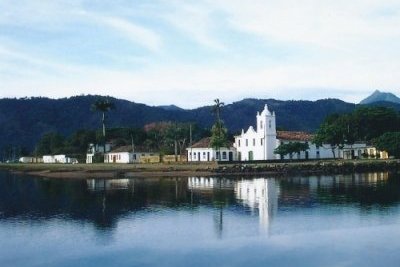
The Brazilian town of Paraty holds the record of having submitted an incomplete dossier: no less than 4 times! But finally, the Brazilians succeeded last year in putting everything together and Paraty will be brought forward as their WH nomination for 2019. Its new title ‘Paraty Culture and Biodiversity’ suggests a very broad approach.
As Gold Route in Parati and its landscape an earlier incarnation of this site was already Deferred in 2009: the main objection at the time was that only a small part of the Gold Route was included. The focus was on the town of Paraty, on which the verdict was “a 19th-century colonial town, although attractive, it is not exceptional and ICOMOS does not consider that Paraty on its own justifies inscription on the World Heritage List”. Possibilities were seen though to include a longer stretch of the Gold Route and/or to extend it to a mixed WHS or a cultural landscape “with high natural values”.
The new nomination called ‘Paraty Culture and Biodiversity’ is a mixed one indeed and a cultural landscape as well. The “Gold Route” has disappeared from the title, so we may assume that the natural setting will become more prominent than the historic route. But let’s be clear: in the end, it’s all about Paraty, a pretty coastal colonial town that is already well on the tourist trail. They might be wanting to attract even more international visitors.
For me, it was an exciting trip just getting to …
Keep reading 0 comments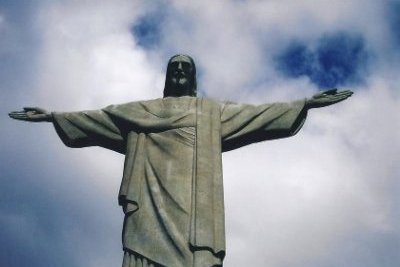
My visit to Rio de Janeiro was a short one, and I was rained out on the first day.
The next morning it was more or less dry. By bus, I went to the Pão de Açúcar (Sugar Loaf). This is the most prominent hill in the landscape of Rio. You get to the top via two cable cars. There may have been 75 people inside and it was pretty busy. At the halfway stop I found the most beautiful: the views of the beaches and the Sugarloaf itself.
A day later the sun was shining again. So a quick taxi ride brought me to the Corcovado, the mountain with the well-known Christ statue. It is reached by a little train, a tourist attraction by itself in Rio. What I found striking was the number of people engaged in the train. It looked like an employment project for the local youth. The train ride took about 20 minutes, passing through the Atlantic rainforest of the Tijuca National Park. A beautiful ride. Up near the statue, there's a beautiful view of the city.
Back at the bottom again I visited the Museum of Naive Art. Definitely worth it, with paintings of Rio and the history of Brazil on show.
Keep reading 0 comments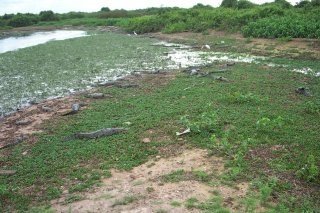
I visited the Pantanal on a 4-day tour from Cuiabá. Not to the protected zone, but to another nice part where there are lots of animals. The tour included all the local fun, like walking, horse-riding, bird spotting and piranha fishing.
Although at the end of October, it was still very dry in this area. Fortunately, because of that, there were not many mosquitos. The wildlife was still abundant though. We saw a tapir, otters, capybara's and alligators.
I think a bird spotter will find real joy in the Pantanal. In almost every tree you can see a wonderful example of the local birds here. To the more common visitor (like I am), the Tuiuiu (a 1.40 m. high creature) is amazing to watch.
Keep reading 0 comments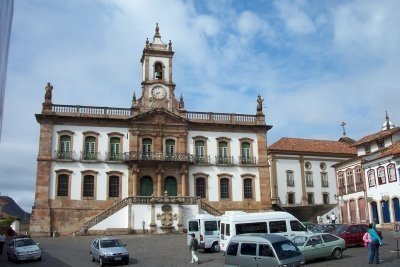
Locals here must be in good physical condition: the town´s cobblestoned streets go up and down and up again. These locals can enjoy themselves though, living in such a great city, wonderfully preserved and indeed very homogeneous in its looks.
I stayed here for three days, which is a good period to get to know the place. I visited museums and churches, but wandering around is also great fun. It doesn't matter where you're going, at about every street corner there's a great view.
Some great spots: the Igreja de Sao Francisco de Assis (with Aleidinhija carvings), the Museum de Oratorio, and the view down from the road to Mariana. You can also explore one of the huge old mines (Mina de Pasagem) just outside the town. Which I did, of course, becoming some kind of mining expert after visiting other mining WHS in Blaenavon (Wales) and Spiennes (Belgium).
Keep reading 0 comments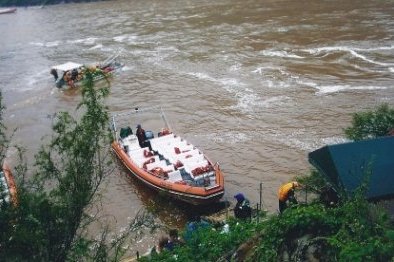
From Foz do Iguacu, I took a public bus to its Argentinian counterpart Puerto Iguazu. From there, another bus brought me to the falls.
This side also has some theme park-feeling. I did give in this time, and joined the Great Adventure. That's when you cross the forest by giant car and then jump into a speedboat. The boat takes you up close to the falls, and somewhat underneath. I got terribly wet and didn't dry until I got back to my hotel in the afternoon and could change clothes.
Somehow the falls look smaller from the Argentinian side. However, strolling through the surrounding forest is very worthwhile here.
Keep reading 0 comments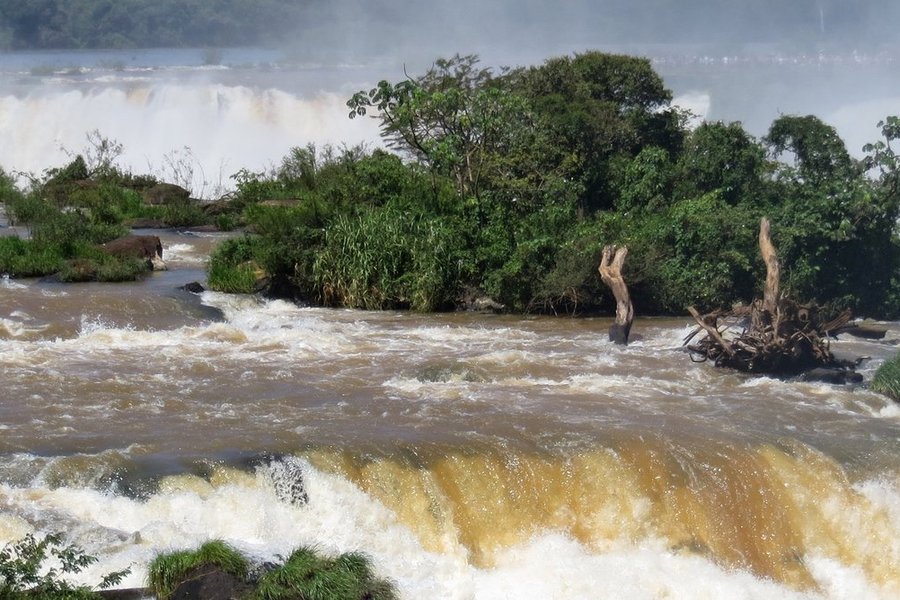
The Brazilian side of the waterfalls can easily be visited from the town of Foz do Iguacu. A bus takes you through the park, which is a bit too touristy for me (but maybe it has become necessary because of the number of visitors).
There's a lot of (manmade things) to see and to do here, but I came only for one: to see the falls in all their glory. And fortunately, that's still possible. From a distance of one or two km (?) you get an overview of the number of falls that together form a big and broad front.
A bit further on, you can get closer and let yourself get wet. Many rainbows colourize the falling water, lovely to see. The butterflies here are also great to watch.
Keep reading 0 comments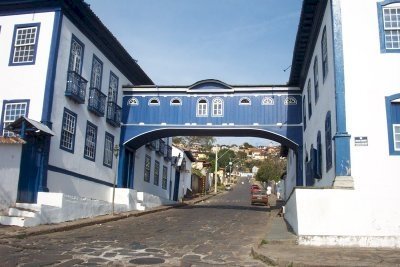
Diamantina really is very different from Ouro Preto for example, and not just another mining town. It's smaller (the historical remains can only be seen in the center of the current city) and soberer. I found that it has some basic beauty.
There were quite a number of Brazilian daytrippers around, but I didn't see any foreign tourists. Maybe that's because it takes 5 hours to get here by bus from Belo Horizonte, not the center of the world itself. It's quite a lively town, with music played in the streets and a number of good restaurants. And (of course) the Diamond Museum. Here you can see some real diamonds (there's a very strong man with a gun guarding them, and selling the entrance tickets). Also, there are paintings that depict how the slaves had to do the digging, and how their masters lived.
In the town center there are a number of good sights. I liked the pure and simple Igreja do Rosario. And also the small houses along the street from there to another church, do Carmo. Not to be missed too is the very blue passageway at the Casa da Gloria.
Keep reading 0 comments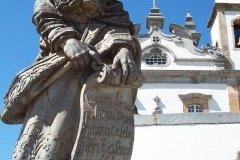
This review could be titled "Getting there and away". Getting there was much easier than I thought beforehand: there's one direct daily bus at 7 am from Ouro Preto. Getting away proved much more difficult: taxis and buses are very scarce in the surroundings of the Basilica to take you away. As are buses back to Ouro Preto - I eventually got there again after a 3 hour's wait in the village of Ouro Branco.
The church and the chapels are extremely picturesque. Set on a steep hill, towering above the humble buildings in the neighbourhood. A clear blue sky as its background. The statues of the prophets are unique pieces, each with its own pose and character. It's good to just sit here and awe.
Unfortunately, you cannot get in at the moment: there are restoration works going on inside the church and some of the chapels. I'm sorry to have missed the rococo interior of the church.
Keep reading 0 comments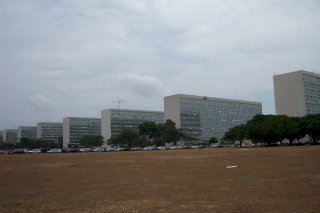
This is a strange city, that cannot be compared to any other in Brazil (or the rest of the world). To be honest: the first thing that came to my mind was that they dropped an atomic bomb here. It must have happened in the early 1970s, in a Bucharest-like city. The people are slowly starting to return now, occasionally you see one or two moving about the fields.
To see some of the architecture, I joined a 3-hour bus tour. We visited 9 places of interest. The most impressive I found was the Sanctuario Dom Bosco. When you step inside this church, you´re surrounded by a blue light shining through the many glass-tiled windows.
The other buildings are a lot soberer. Some are beautiful in their simplicity (like the Church of Our Lady of Fatima), others are quite depressing (like the highrise buildings that were built for the ministries).
Keep reading 0 comments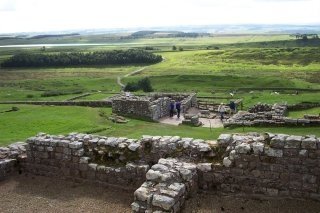
I toured the eastern part of Hadrian's Wall by bus from Newcastle, in the appropriately named AD122. This public bus stops at all things worth seeing along the way, so you can hop off and catch a later bus after you've visited the site. A good service I think.
My first stop was at Housesteads, the remains of a fort just at the wall. Because it was built on a hill, there are fine views over the countryside here.
Vindolanda is a bigger complex, somewhat inland from the wall. This Roman site is actually older than Hadrian's wall itself. Archeological excavations are still underway here, and some reconstruction has been done so it is easier to imagine what it looked like in ancient times. It's also the finding place of the historically quite spectacular Roman writing tablets, that tell about daily life in this area in Roman times.
Keep reading 0 comments
The first view of Durham, from the train or walking down from the railway station, is very impressive. The town is dominated by what looks like a huge fortress; in fact, it is the medieval complex of a cathedral and a castle. Quite hard to encapture this sight into a picture, though. I climbed bridges and followed the riverside footpath, but to no avail.
The front of the Cathedral is massive, but the whole thing is huge when you look at it from the side. The grey stones also dominate the inside, giving it a heavy air although the pillars are distinctly decorated.
Somehow, I didn't find the time to go inside the castle. There are guided tours a few times a day, but I preferred sitting on a bench, reading a book, sipping some coffee, and looking up every ten minutes or so to enjoy the magnificent architecture.
Keep reading 0 comments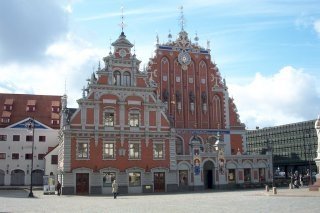
Walking around in Riga (you really have to pack good shoes here), what most surprises is the eclectic architecture. Notably in the Old Town, there is always a medieval highlight next to some Stalinist leftovers. This diversity in styles adds a lively atmosphere to the town. Generally, Riga is less open-air-museum-like than Talinn for example.
The main reason for inclusion is Riga's fine collection of Art Nouveau buildings. They can be found a few blocks north of the city center. There are several streets adorned with great specimens. The buildings by Mikhail Eisenstein are well restored and freshly painted.
Another feature of Riga is the 19th-century wooden buildings. They are less prominent than the Art Nouveau ones and less often renovated.
Keep reading 0 comments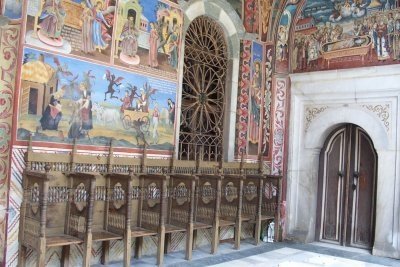
Inaccessible for the medieval man, still a time-consuming trip for the modern traveller. From Sofia it takes almost all day by public transport to get there (and back), so I decided to be clever and rent a car. And this also took me the best part of the day....
Driving in Bulgaria means escaping the potholes in the streets, pedestrians crossing 'the highway', circling around the ubiquitous horse carriages, dead dogs and other runover animals. This can be fun, but what they add is totally erratic signposting. Although I had a detailed road map in Cyrillic, I took the wrong way seriously three times. In all, it cost some four hours to arrive at the monastery 120 kilometers from Sofia. What a day...
Here the lamenting stops: because it was worth all the trouble. Rila's is the most awe-inspiring, colourful and eccentric monastery I have ever been to (and I've seen many). Its location, in the dark green forests and with snow-clad mountains in the background, couldn't be better. The outside walls are a bit bleak, but entering via the Dupnitsa-gate, my mouth fell open taking in the spectacle. I can't begin to describe the colours, the frescoes, the architecture, and all the details, but I hope I can give an impression via the pictures on this site.
Keep reading 0 comments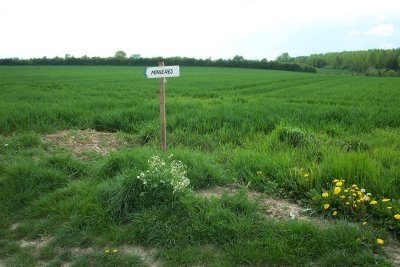
Over the last months, I enjoyed the 'discussion' below among the visitors about how to get to the mines in Spiennes (and even more important - how to get in). But gradually the basic visitor information became clear: there are guided tours on the first Sunday every month, and you have to be very alert in the town of Spiennes to spot the site. To make it even easier: via the link 'Mining site of Spiennes' above there's access to a map.
Besides an extra round on the Mons Ring road (there's only a small sign to Beaumont), I had no trouble finding it. In Spiennes the 'minieres' are even signposted. From above the ground, the site looks remarkable like any farming field. The archeological excavations are limited to two areas: one official site and one for volunteers.
One of the guides showed me around. First some open excavations on the surface. After that we descended a steep iron ladder, to get 10 meters below the ground. Here we arrived in a well-lit cave network (the electrical lights were only recently installed). The difference between the white chalk and the 2 flint layers was clearly visible. The guide explained the techniques used by the neolithic people to get to the flint. It was a tough and patient job carried out precisely. An amazing experience to stand here thousands of years later.
Keep reading 0 comments
Maps were unfolded at my hotel when I asked about how to go to Zhoukoudian. It didn't become very clear if there is a bus going there, so I opted to hire a taxi for a few hours. The driver didn't know how to get there either, but with a map and some directions asked underway we drove to Zhoukoudian. After leaving the expressway, we even encountered a large sign "Peking Man World Heritage Site, Zhoukoudian", accompanied by a picture of Peking Man himself and the Unesco logo. At the end of the road through town, we stumbled upon a parking lot and a ticket office (marked Beijing ren). I was pleased to have made it here, as it looked like not many people ever got here.
Behind the entrance, following steep steps through the woods, the first place to see is the Peking Man cave (the one that was discovered in 1921). Signs in English detail the findings here. I had the place all to myself, it was so quiet that I expected some prehistoric animal to creep from under the stones. A great place to contemplate man's life during the past 500.000 years though.
I walked around the other caves and the interesting museum. The phrase 'Few go to visit Peking Man site anymore' (the title of a Seattle newspaper article you can find in the links section above) didn't prove true today however: about half an hour after I had arrived, some twelve buses filled …
Keep reading 0 comments
I spent two full days in this city, four hours north of Beijing by bus. Chengde itself is a nice enough encounter with Chinese city life outside the capital. No Mcdonald's or Starbucks can be found here. What it does have is steam trains - an internet search in preparation for this trip resulted in many exciting stories by trainspotters.
But I had my own spotting to do: the Chengde Imperial Resort as World Cultural Heritage. On my first day, I explored the huge park. Don't be fooled by the somewhat standard Chinese gates and buildings at the entrance: when you've passed them you enter a lovely landscape park. There are several lakes, a steppe, and a forest. In the best "natural" spots, pavilions and temples were added. For example the tall and elegant Yongyou si Pagoda.
The next day I walked to some of the outlying temples. Most prominent is the Putuozongsheng, modelled after Lhasa's Potala Palace. It's a strange sight to see it here, in northern China, as well as in the neighbouring Xumifushoumiao (a recreation of the Tashilhunpo monastery in Xigaze). Both are well looked after and brightly painted, but lack the atmosphere of an active Buddhist monastery.
Keep reading 0 comments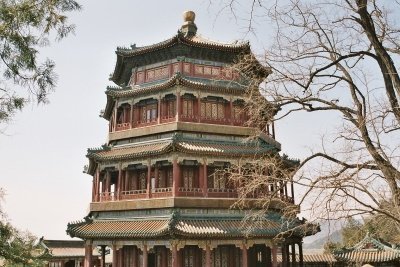
This involves a nice bus trip (costing 0,15 euro) to the outskirts of Beijing passing its university. The 'new' Summer Palace is awesome. It's a group of buildings scattered on a hill and along the lakeside. I just couldn't stop taking pictures of the Temple of Wisdom. I think I've fallen in love with yellow and green tiles here in Beijing. And this temple has them all over, together with innumerable little Buddha statues (the ones closest to the ground missing their heads).
When I finally wanted a break after gazing at all the temples, pagodas, halls and so on, I stopped for lunch at the Palace's restaurant. After almost one week in Beijing I encountered them here for the first time: can't-be-bothered waitresses huddled together in a corner, hissing mei you when you order something not too spectacular. Enjoy the old-communist ways at the Tingliguan restaurant, with its yellow chairs, plastic table cloths, and darkened windows (no lights switched on). It was fun to see all western tourists peeking around the door, and immediately back off, while I enjoyed my shredded pork with green peppers.
The next day I went to the Old Summer Palace, which is now in ruins. It's like visiting ancient sites in Greece or Italy, though the Summer Palace is quite new compared to them. At most of the sites they placed a model to show how the buildings must have looked while they were still standing. They all look like reproductions of …
Keep reading 0 comments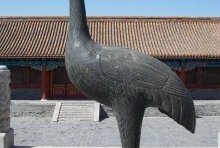
The Forbidden City is a huge complex at the center of Beijing (behind the Tiananmen gate), that nowadays attracts thousands of visitors every day. I entered from the North, so I was met with innumerable (mainly Chinese) groups that had started from the main entrance in the South.
The funny thing is that everybody clings to the main path (the North-South axis) and that 10 meters to the right or left you're almost on your own.
The complex is surely meant to impress: everything is just huge. You have to take your time to find and look at the details. What I liked most were its simple but effective colours: bright red walls, with green and yellow accents in the tiles.
Keep reading 0 comments